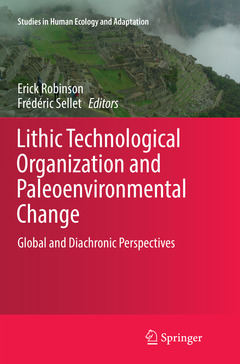Lithic Technological Organization and Paleoenvironmental Change, Softcover reprint of the original 1st ed. 2018 Global and Diachronic Perspectives Studies in Human Ecology and Adaptation Series, Vol. 9
Langue : Anglais
Coordonnateurs : Robinson Erick, Sellet Frédéric

The objective of this edited volume is to bring together a diverse set of analyses to document how small-scale societies responded to paleoenvironmental change based on the evidence of their lithic technologies. The contributions bring together an international forum for interpreting changes in technological organization - embracing a wide range of time periods, geographic regions and methodological approaches.? ?As technology brings more refined information on ancient climates, the research on spatial and temporal variability of paleoenvironmental changes. In turn, this has also broadened considerations of the many ways that prehistoric hunter-gatherers may have responded to fluctuations in resource bases. From an archaeological perspective, stone tools and their associated debitage provide clues to understanding these past choices and decisions, and help to further the investigation into how variable human responses may have been. Despite significant advances in the theory and methodology of lithic technological analysis, there have been few attempts to link these developments to paleoenvironmental research on a global scale.
1: Lithic Technological Organization and Paleoenvironmental Change.- 2: Provisioning Responses to Environmental Change in South Africa’s Winter Rainfall Zone, MIS 5-2.- 3: The South Asian Microlithic: Homo sapiens Dispersal or Adaptive Response?.- 4: The Hoabinhian of Southeast Asia and its Relationship to Regional Pleistocene Lithic Technologies.- 5: Horizons of Change: Entanglement of Paleoenvironment and Cultural Dynamics in Australian Lithic Technology.- 6: Human Adaptive Responses to Environmental Change During the Pleistocene-Holocene Transition in the Japanese Archipelago.- 7: Isolation, Exploration, or Seasonal Migration? Investigating Technological Organization in the Late Middle Paleolithic of Britain During Marin Isotope Stage 3.- 8: Proto-Aurignacian Lithic Technology, Mobility, and Human Niche Construction: A Case Study from Riparo Bombrini, Italy.- 9: Environmental Change and Technologica
l Convergence in Southern Germany.- 10: Technology and Human Response to Environmental Change at the Pleistocene-Holocene Boundary in Eastern Beringia: A view from Owl Ridge, Central Alaska.- 11: Technological Change from the Terminal Pleistocene Through Early Holocene in the Eastern Great Basin, USA: The Record from Bonneville Estates Rockshelter.- 12: My Flute is Bigger Than Yours: Nature and Causes of Technological Changes on the American Great Plains at the End of the Pleistocene.- 13: The Peopling of Southeastern South America: Cultural Diversity, Paleoenvironmental Conditions, and Lithic Technological Organization During the Late Pleistocene and Early Holocene.- 14: Changes in Technological Organization and Human Use of Space in Southern Patagonia (Argentina) During the Late Holocene.- 15: The Costs and Benefits of Technological Organization: Hunter-Gatherer Lithic Industries and Beyond. Erick Robinson is a postdoctoral researcher in the Department of Anthropology at the University of Wyoming. He specializes in geochronology, lithic technology, and paleodemography, focusing on hunter-gatherer adaptations to terminal Pleistocene and Holocene environmental change and transitions to agriculture in northern Europe and Western US. He is currently working to develop a comprehensive archaeological radiocarbon database for the US that will be used to reconstruct prehistoric population growth and migration throughout the Holocene.
Frederic Sellet
Links stone tool usage and paleoenvironmental research Includes case studies from the Lower Pleistocene to the Holocene and features archaeological examples from every continent Focuses on paleoenvironmental data that will make it attractive to climatologists, geoarchaeologists, human ecologists and geographers.
Date de parution : 06-2018
Ouvrage de 341 p.
15.5x23.5 cm
Date de parution : 11-2017
Ouvrage de 341 p.
15.5x23.5 cm
Thèmes de Lithic Technological Organization and Paleoenvironmental... :
© 2024 LAVOISIER S.A.S.


